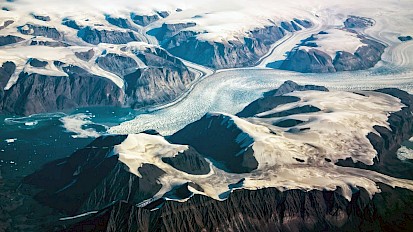How Greenland’s ice streams could have major impact on sea level rise
 New radar technology allowing scientists to examine the Greenland ice sheet has revealed that major flows of ice across the continent can change much more rapidly than was previously thought.
New radar technology allowing scientists to examine the Greenland ice sheet has revealed that major flows of ice across the continent can change much more rapidly than was previously thought.
The Greenland ice sheet is a critical reservoir of water, holding enough to raise global sea levels by over 7.2 metres (24 feet) if it were all to melt.
Recent research shows the ice sheet is already on course to raise sea levels by a minimum of 27cm (10.6in) by the end of this century alone, with major implications for coastal populations.
Scientists in Germany examining the complex processes governing the ice sheet have now shown that Greenland’s major ice streams can shut down, shifting rapid ice transport to other parts of the ice sheet, within just a few thousand years.
An ice stream is the movement of solid ice – not melting – typically carrying ice from the centre of the ice sheet to the coast, however the rate of this movement has a significant bearing on the ice sheet’s potential for raising global sea levels as the environment responds to the heating caused by the climate crisis.
As well as rising temperatures causing melting on the ice sheet’s surface and base, the sheet loses mass through its numerous ice streams, which the research team described as being “essentially conveyor belts for rapid ice transport from the inner sheet to its edge”.
Due to the rapidly-changing environment, the routes of past ice streams can be accurately reconstructed in the now glacier-free areas at the sheet’s edge, as the landforms they leave behind offer clearly visible clues.
However, until recently, very little was known about the activity of past ice streams in the inland Greenland ice sheet, since the area is difficult to access.
The answer? The team deployed cutting-edge measuring technologies including high-resolution radar systems able to penetrate the ice and map the structures that lie several thousand metres below the surface of the ice sheet.
“Thanks to our ice-penetrating radar data, we can show how quickly the Greenland ice sheet’s ice transport system reconfigured itself,” said glaciologist Dr Steven Franke from the Alfred Wegener Institute (AWI) at the Helmholtz Centre for Polar and Marine Research, who is first author of the study.
“Major ice streams can shut down within a few thousand or even several hundred years, while others appear elsewhere at a similar speed,” he said.
“Until now, no-one had any idea that the streams of this scale could change so quickly.”
Ice transport involving the flow of solid ice seen in these ice streams is a facet of ice sheet dynamics which must be more actively integrated into forecasts of how much the Greenland ice sheet could contribute to sea-level rise in a variety of future climate scenarios, the team said.
Currently, all ice sheet melt models lack observations on ice-stream instability.
The ice’s flow history, now made visible by radar, offers climate scientists crucial new insights into how the ice sheet has changed in the past and what it could mean for the future.
The data made available by the study was gathered on flights with the AWI’s research aeroplane Polar 6, and from Nasa’s Operation IceBridge in central Northeast Greenland, where only very low flow speeds can currently be observed in the ice.
The team of researchers identified two paleo ice streams, which were once active and now lie buried under several hundred metres of ice. Their analyses show that these ice streams were active into the Holocene (less than 11,700 years ago) and extended far into the inland ice of central Northeast Greenland.
“The radar signature of one of the two paleo ice streams, which we used to reconstruct past ice-stream activity, is remarkably similar to that of the massive and still active North East Greenland Ice Stream,” said AWI glaciologist Dr Daniela Jansen, head of the project on past ice streams that produced the publication.
This discovery, she claims, could offer new insights into the future behaviour of the ice stream, the formation and stability of which are the subject of considerable debate.
You can return to the main Market News page, or press the Back button on your browser.

